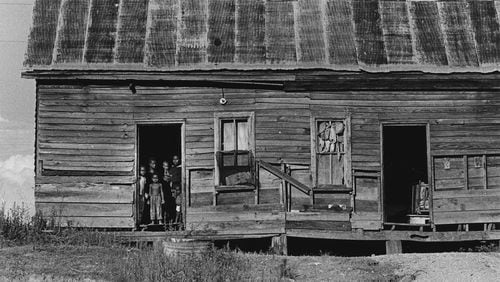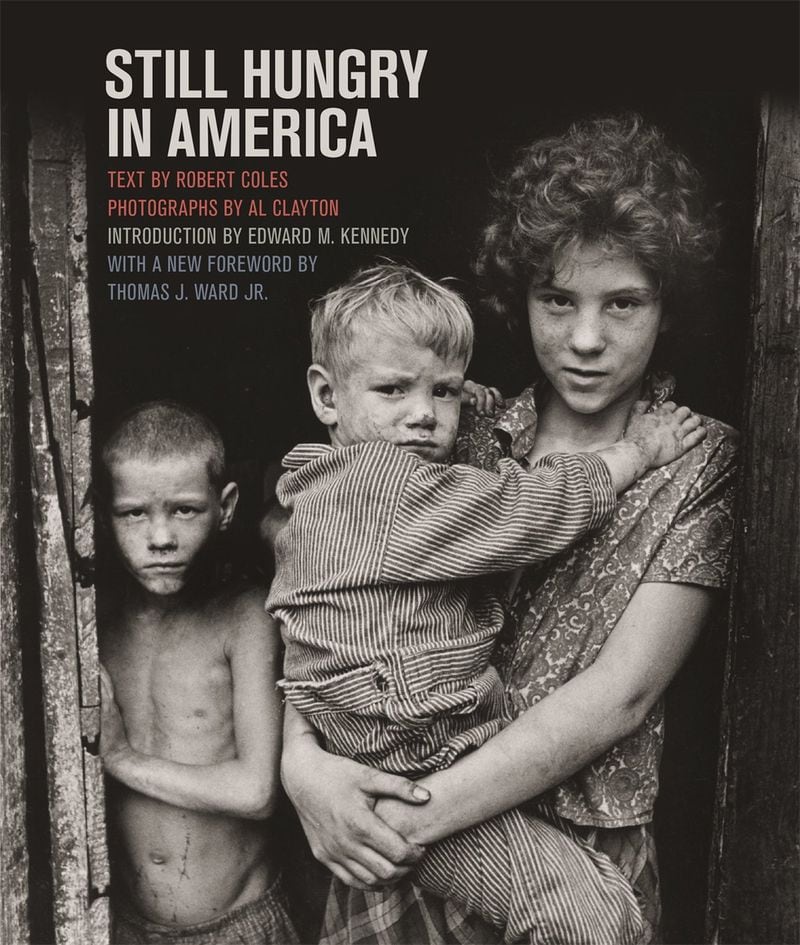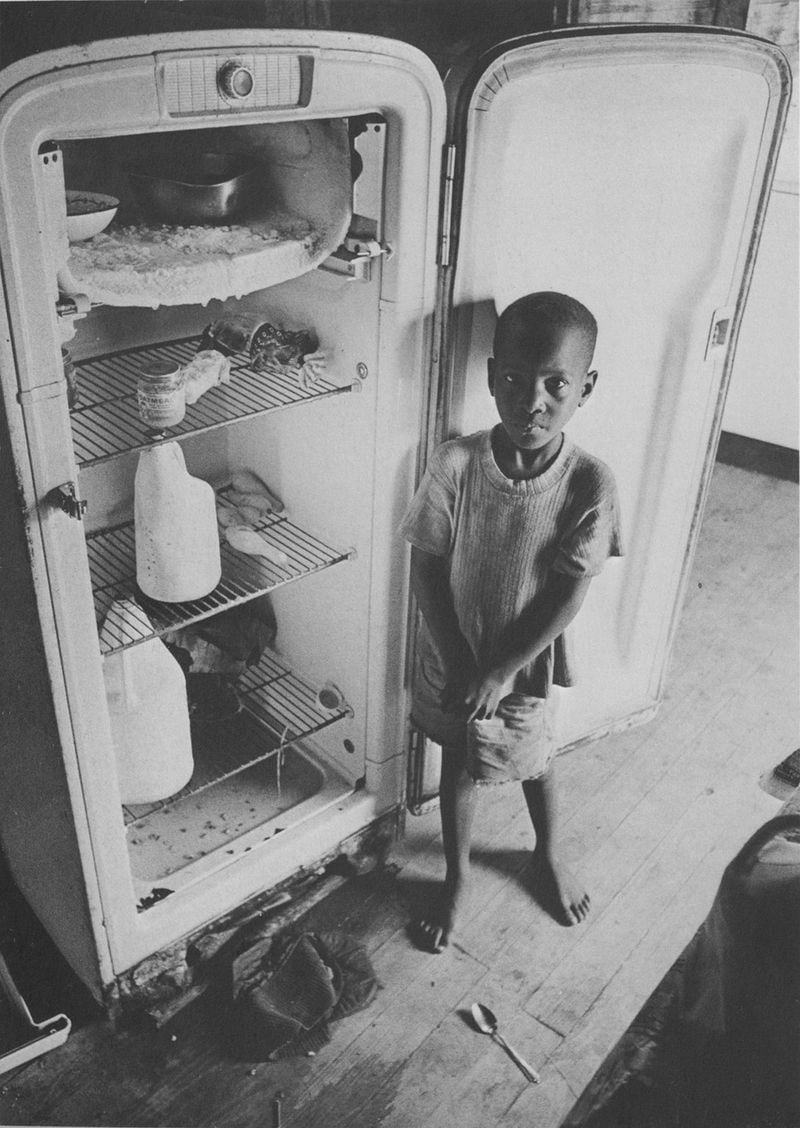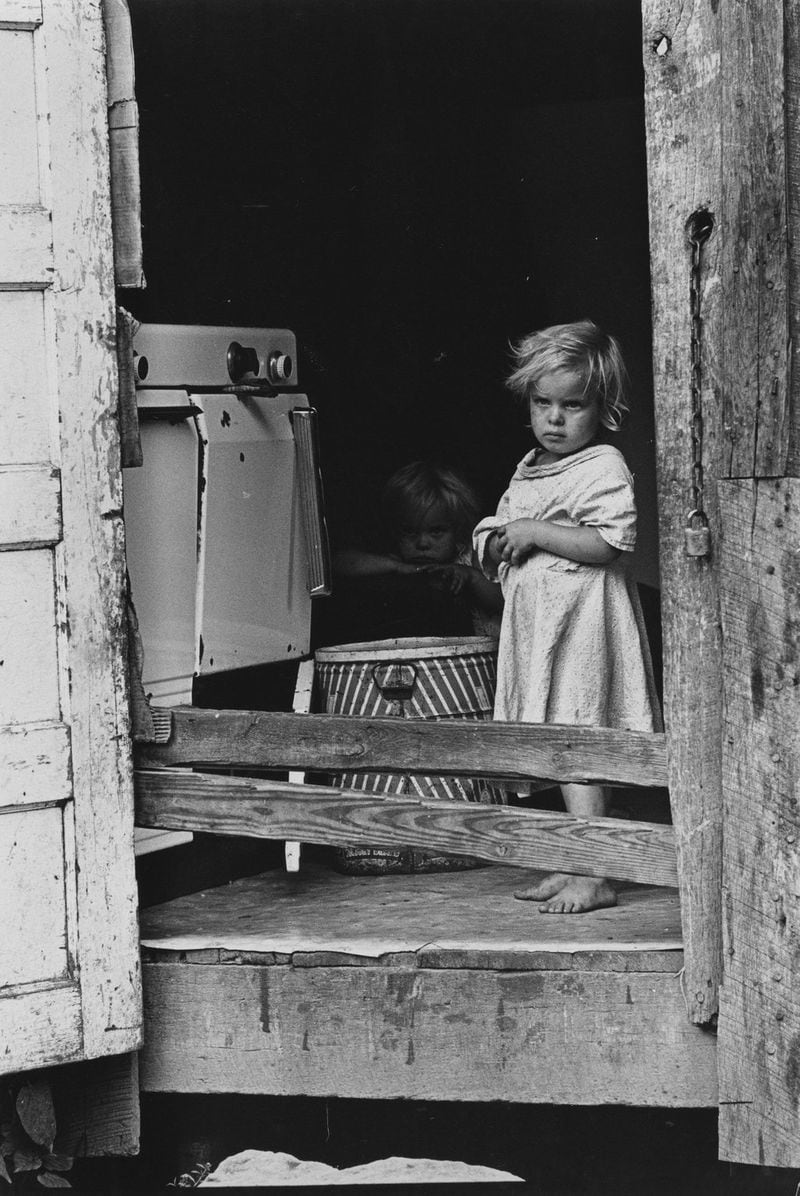Standing in the doorway, a stick-thin arm protectively crossed against his solar plexus, the dirty-faced boy stares with furrowed brow at the camera.
He’s not the focal point of the black-and-white photograph. That’s reserved for the pre-adolescent girl and toddler, whom she holds in her arms with the self-assurance of a seasoned mother.
The boy huddles in their shadow. He looks to be around 8 years old. In contrast to the other children, who appear more robust by comparison and have full heads of hair and adequate clothing, his head is shaved and he is shirtless. The architecture of his rib cage is visible beneath skin stretched taut across his tiny chest. Below it protrudes a swollen belly covered with scratch marks. A shadow falls over his cheek, accentuating the gauntness of his face. But it is the wounded look in his eyes that holds the viewer’s gaze. It is the look of a child in despair.
Credit: University of Georgia Press
Credit: University of Georgia Press
Shot in 1967, the image is one of many taken to document the ravages of poverty throughout the South by the late photographer Al Clayton. Commissioned by the Southern Regional Council, the photos were presented at a congressional hearing on poverty that ultimately led to an expansion of the U.S. food stamp program. A half-million people received food stamps in 1965. That number climbed to 15 million by 1974.
Two years after the hearing, those startling photographs were published in the book "Still Hungry in America," which has been republished by the University of Georgia Press in conjunction with the Southern Foodways Alliance. In addition to the original text and introduction — written by Robert Coles, a professor emeritus of Harvard and a scholar on poverty, and U.S. Sen. Ted Kennedy, respectively — there is a new foreword by Thomas J. Ward, the chairman of the history department at Spring Hill College in Mobile, Ala.
“These pictures … offer us a mixed kind of spectacle, a terribly shameful, unsettling and edifying view of the extreme distress and the redemptive possibilities that continue to exist, side by side, in the very same people — our people,” Cole wrote of Clayton’s images.
The photographs conjure comparisons to Walker Evans’ documentation of the Great Depression and Dorothea Lange’s images of the Dust Bowl. That Clayton’s photos were taken more than 30 years later was a point not lost on Congress.
But a closer examination of Clayton’s work reveals a level of warmth and engagement less apparent in the work of Evans and Lange. Perhaps that’s because, as Clayton told NPR in 2006, he often talked to his subjects while he photographed them. As a result, he was able to capture an arresting level of intimacy.
“They just had a quality of sensitivity and sympathy that was above and beyond the call of photographic duty,” writer and Blue Ridge resident William Hedgepeth said. A writer for Look magazine at the time, Hedgepeth attended the congressional hearing and was so taken by the photos, he immediately enlisted Clayton’s services on his next story. They would spend the next 30 years collaborating on projects.
Clayton became a photographer by accident. The Etowah, Tenn., native joined the Navy in 1952 for the sole purpose of getting the G.I. Bill to pay for medical school so he could become a surgeon. Given the rank of hospital corpsman, he was stationed at a hospital for Marines.
“One day they were doing a surgery and somebody handed him a camera and asked him to take pictures,” said his daughter, Jennie Clayton of Gainesville. “He was done. Being a doctor or surgeon was over at that point.”
Clayton left the Navy in 1958 and went to art school in Los Angeles. Afterward, he returned to the South, first to Nashville, then in 1972 to Atlanta, where he stayed and built a career, alternating between lucrative commercial assignments and journalistic projects, many with Hedgepeth at his side.
Among the topics the pair worked on together: the Nigerian Civil War in Biafra, the rise of a new Confederacy in the South, snake handlers, homelessness, hunger, hogs and roadkill. Clayton also photographed more than 100 album covers for artists such as Bob Dylan, Johnny Cash, George Jones and Townes Van Zandt, and he toured with the Allman Brothers in 1974. Not content to limit his creativity to still photography, he also made a documentary film on snake handling called "In Jesus' Name."
“He was a real religious person,” Hedgepeth said. “He and I came to a religious understanding. It was not so much centered on the worship of God, but centered on the basic holiness of people. He was extremely moved by things. When we returned from Biafra, he checked into a hotel room in New York and sobbed for a whole day.“
Clayton continued to work until shortly before his death in 2014 from a rare condition that affected his autonomic nervous system. While his work may echo that of Evans and Lange, his name recognition has not fared as well over the years. His daughter, Jennie, would like to change that. Lumiere Gallery in Atlanta is showing some of his photographs in a group exhibit through May 25, and his works are in the permanent collections of the Mississippi Civil Rights Museum and the Museum of Contemporary Art — Georgia. About 30 percent of his negatives and contact sheets are archived in the special collections library at the University of North Carolina, Chapel Hill. Jennie hopes the rest of his work will find a home there, too.
Meanwhile, the project that first put him on the map is back in circulation, and its topic is still as emotionally charged as it was then. In 2014, more than 48 million Americans were “food insecure,” according to the U.S. Department of Agriculture. And last month, President Donald Trump proposed replacing food stamps with boxes of food.
“Still Hungry in America” is a reminder of just how bad it can get.
“Al Clayton used his immense talent to ask questions of the South, to ask questions of America,” said John T. Edge, the director of the Southern Foodways Alliance. “His work benefits, in equal measure, from empathy and indignation. The Southern Foodways Alliance is honored to play a role in reintroducing his masterwork.”
'Still Hungry in America.' Photographs by Al Clayton, text by Robert Coles, introduction by Edward M. Kennedy and a new foreword by Thomas J. Ward. 115 pages. $32.50. Southern Foodways Alliance series. University of Georgia Press.
About the Author










